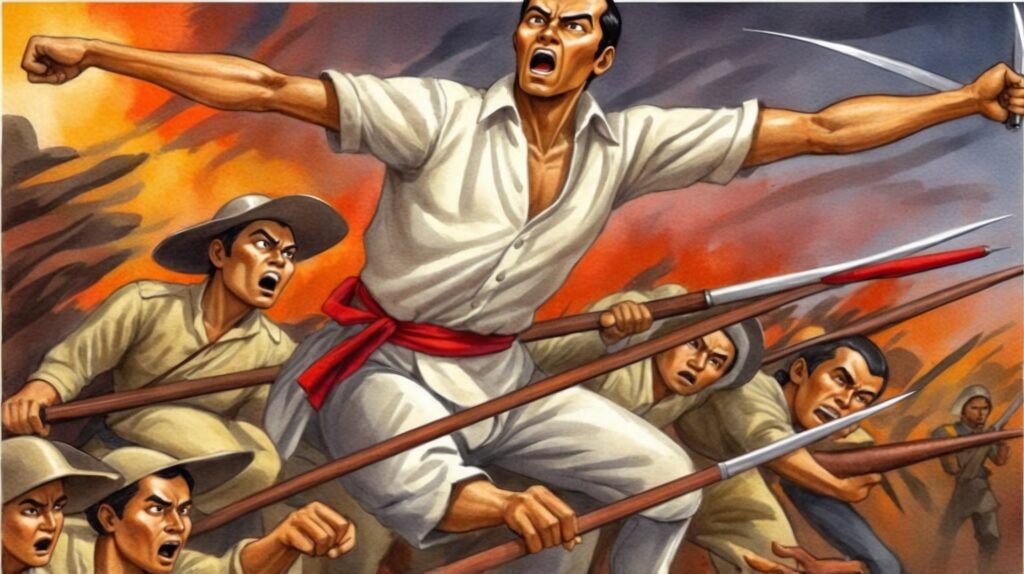Growing up in the bustling district of Tondo, Manila, Andres Bonifacio’s early life wasn’t exactly the stuff of privileged childhood dreams. Born on November 30, 1863, to Santiago Bonifacio and Catalina de Castro, young Andres faced adversity early when both his parents passed away due to illness when he was just a teenager. As the eldest of six siblings, he had to drop out of school and take on the responsibility of providing for his younger brothers and sisters. Talk about pressure – while most teenagers were probably worrying about their next game of sungka, Bonifacio was juggling jobs as a craftsman, messenger, and warehouse keeper just to keep food on the table. Despite these challenges, his thirst for knowledge never wavered, and he self-studied by reading everything he could get his hands on, from Victor Hugo’s “Les Misérables” to books about the French Revolution. Who knew that reading about French people overthrowing their government would come in handy later?
From Warehouse Keeper to Revolutionary Leader: The Making of El Supremo
The Path to Revolution
Life has a funny way of turning ordinary people into extraordinary leaders, and Bonifacio’s journey is a testament to this. Working as a warehouse keeper for foreign firms like Fleming and Company and Fressell and Company, he developed not just business acumen but also a growing awareness of the social injustices around him. It’s worth noting that while he was organizing a revolution, he was also technically an employee of the month material – talk about work-life balance! His involvement in Jose Rizal’s La Liga Filipina in 1892 marked his first step into organized resistance against Spanish colonial rule. When the Spanish authorities disbanded La Liga Filipina (spoiler alert: they weren’t fans), Bonifacio, along with others, founded the Katipunan on July 7, 1892.
Here’s a breakdown of the Katipunan’s early membership growth:
| Year | Number of Members | Notable Events |
|---|---|---|
| 1892 | ~300 | Founding year |
| 1893 | ~1,000 | Expansion to provinces |
| 1894 | ~2,000 | Women’s chapter established |
| 1895 | ~10,000 | Rapid growth phase |
| 1896 | ~30,000 | Revolution begins |
(Source: National Historical Commission of the Philippines)
The Revolution Begins: When Things Got Really Serious
The Cry of Pugad Lawin
Remember that time you tried to organize a simple group project and it was chaos? Well, multiply that by about a million, and you’ll get an idea of what Bonifacio was dealing with. On August 23, 1896, in Pugad Lawin (now part of Quezon City), Bonifacio and his fellow Katipuneros performed the famous “Cry” – tearing their cedulas (residence certificates) and shouting “Long live the Philippines!” This wasn’t just a case of extreme littering; it was a symbolic act of defiance against Spanish rule. The revolution had officially begun, and there was no turning back. What followed was a series of battles, strategic meetings, and probably a lot of sleepless nights for everyone involved.
Leadership Style and Strategic Decisions: Not Your Average Office Manager
Revolutionary Tactics and Organization
Bonifacio’s leadership style was unique for his time. While he might not have had formal military training, he made up for it with sheer determination and organizational skills that would make any modern CEO jealous. He established a revolutionary government, complete with its own constitution, laws, and administrative structure. Think of it as a start-up nation, but instead of disrupting the tech industry, they were disrupting colonial rule.
Here’s a look at the Katipunan’s organizational structure:
| Position | Role | Responsibilities |
|---|---|---|
| Supremo | Supreme Leader | Overall leadership |
| Pangalawang Supremo | Deputy Leader | Second-in-command |
| Pangulo | President | Administrative duties |
| Kalihim | Secretary | Record keeping |
| Tagapangalaga | Treasurer | Financial management |
(Source: Philippine Historical Archives)
Legacy and Impact: More Than Just a Face on the Coin
Bonifacio’s influence on Philippine society extends far beyond his time. Today, his face graces the five-peso coin, and his birth date, November 30, is a national holiday. But his real legacy lies in how he transformed a nation’s consciousness. He showed that revolution isn’t just about military might – it’s about organizing, inspiring, and mobilizing people toward a common goal. Think about it: he basically created a viral movement before social media was even a thing!
Here are some lasting impacts of Bonifacio’s revolution:
| Area of Impact | Description | Modern Relevance |
|---|---|---|
| Political | Established concept of Filipino nationalism | Basis for modern Philippine democracy |
| Social | Promoted equality and brotherhood | Influences current social justice movements |
| Cultural | Enhanced Filipino identity | Continues to inspire arts and literature |
| Educational | Emphasized importance of knowledge | Model for educational reforms |
(Source: Department of Education, Philippines)
Bonifacio in the Modern Context: What Would He Think of Today?
Relevance in Contemporary Philippines
If Bonifacio were alive today, he’d probably be both proud and concerned about the state of the Philippines. On one hand, we’re independent (mission accomplished!), but on the other hand, we’re still fighting different forms of modern colonialism – economic dependencies, cultural imperialism, and that weird obsession with foreign brands. His principles of sovereignty, equality, and social justice remain relevant in addressing contemporary challenges like corruption, poverty, and social inequality.
Lessons for Modern Filipinos: Because History Is More Than Just Boring Dates
Bonifacio’s life teaches us several valuable lessons that are still applicable today:
- Education doesn’t just happen in classrooms. Bonifacio was largely self-taught, proving that learning is a lifelong journey.
- Leadership isn’t about pedigree; it’s about purpose. He showed that greatness can come from humble beginnings.
- Revolution doesn’t always mean violence. Sometimes, it’s about organizing, inspiring, and mobilizing people toward positive change.
- Standing up for what’s right isn’t always popular, but it’s necessary.
Celebrating Bonifacio Day: More Than Just a Day Off
Modern Commemorations and Celebrations
Today, Bonifacio Day celebrations include wreath-laying ceremonies, historical reenactments, and various cultural activities. But perhaps the best way to honor his memory is to embody the values he fought for: love for country, courage in the face of adversity, and the willingness to stand up for what’s right. And maybe, just maybe, read a good book or two – he would have approved of that.
Conclusion: The Revolution Continues
Andres Bonifacio’s story reminds us that great changes often start with ordinary people doing extraordinary things. His revolution might have begun in 1896, but the fight for social justice, equality, and national sovereignty continues in different forms today. As we commemorate Bonifacio Day, let’s remember that we don’t need to tear up cedulas to be revolutionary – sometimes, standing up for what’s right in our daily lives is revolutionary enough.
Disclaimer: This article has been thoroughly researched using historical records and official sources. However, historical accounts can vary, and new information may emerge over time. If you notice any inaccuracies or have additional verified information to contribute, please contact our editorial team at [email protected] We are committed to maintaining historical accuracy and appreciate your help in this endeavor.
SEO Keywords: Andres Bonifacio, Philippine Revolution, Katipunan, Bonifacio Day, Philippine history, Filipino heroes, Cry of Pugad Lawin, Spanish colonial period, Philippine independence, Filipino nationalism.




